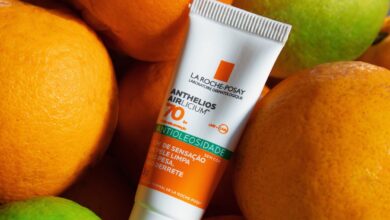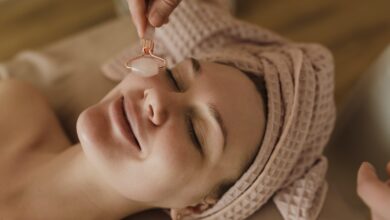
Introduction: Embrace the Fall Season with a Skincare Routine
As the leaves change color and the air becomes crisp, it’s time to transition your skincare routine to combat the effects of autumn on your skin. The cooler temperatures and lower humidity levels can lead to dry, flaky skin, making it essential to adjust your skincare arsenal accordingly. In this comprehensive guide, we will explore the impact of autumn on your skin, the science behind dry skin, and provide you with expert tips and tricks to keep your skin nourished and glowing throughout the season.

Autumn in Dubai brings a subtle change in weather, with slightly cooler temperatures and occasional gentle breezes. This shift in climate calls for a slight adjustment in skincare routines. As the humidity decreases and the air becomes drier, it is essential to keep the skin hydrated and protected. The combination of cooler temperatures and indoor heating can lead to skin dehydration, making it crucial to use hydrating and moisturizing products.
Additionally, the gentle breezes can carry dust particles, so it is important to cleanse the skin thoroughly to prevent clogged pores and breakouts. Overall, autumn in Dubai requires a skincare regimen that focuses on maintaining moisture levels, protecting the skin from environmental factors, and promoting a healthy, radiant complexion.
Understanding the Impact of Autumn on Your Skin
During autumn, the transition from the hot and humid summer to the cooler and drier weather can take a toll on our skin. As the temperature drops and humidity levels decrease, our skin begins to lose moisture at a faster rate. This loss of moisture leads to dryness and dehydration, causing our skin to feel tight, flaky, and even itchy.
The gusts of wind and harsh weather conditions that often accompany the fall season can further worsen these issues. The wind can strip away the natural oils that act as a protective barrier for our skin, leaving it vulnerable and more prone to damage. This can result in a compromised skin barrier, which not only exacerbates dryness but also increases the risk of irritation, redness, and inflammation.
Understanding the impact of autumn on our skin is crucial because it allows us to develop an effective skincare routine that specifically addresses these concerns. By incorporating the right products and practices into our daily regimen, we can help combat the adverse effects of the changing weather conditions.
Firstly, it is essential to focus on hydration. This means using moisturizers that are richer and more nourishing, as they will help replenish the lost moisture and prevent further dehydration. Look for ingredients like hyaluronic acid, glycerin, and ceramides, which work to attract and retain moisture in the skin.
Additionally, it is crucial to protect the skin’s natural barrier by using products that contain occlusive ingredients. Occlusives help to seal in moisture and prevent water loss from the skin. Ingredients such as shea butter, beeswax, and petrolatum are effective in creating a protective barrier that shields the skin from the harsh elements.
Incorporating gentle exfoliation into your skincare routine can help remove dead skin cells and promote cell turnover, allowing for better absorption of moisturizers and serums. However, it is important to avoid over-exfoliating, as this can further damage the skin barrier. Opt for mild exfoliants, such as those containing alpha-hydroxy acids or enzymes, and limit their use to once or twice a week.
In addition to adapting your skincare products, adjusting your overall lifestyle habits can also contribute to healthier skin during autumn. Drinking plenty of water helps to hydrate the skin from within, while a balanced diet rich in antioxidants and healthy fats can support skin health. Moreover, protecting your skin from the sun’s harmful UV rays, even during the cooler months, is essential to prevent further damage and premature aging.
Autumn brings about significant changes in weather conditions that impact our skin. By understanding these effects, we can develop a skincare routine that effectively addresses the challenges posed by the drop in temperature, humidity, and harsh weather. By focusing on hydration, protecting the skin barrier, incorporating gentle exfoliation, and adopting healthy lifestyle habits, we can keep our skin nourished, hydrated, and radiant even during the autumn season.

The Science Behind Dry Skin: Why Does it Happen?
Dry skin occurs when the skin’s natural moisture barrier, which is responsible for maintaining hydration and moisture levels, becomes compromised. This can happen due to a variety of factors, including environmental conditions, genetics, and lifestyle choices.
Environmental conditions play a significant role in causing dry skin. During autumn, for example, cold weather and low humidity levels can disrupt the skin’s moisture balance. The cold air outside and the heated indoor environment can strip the skin of its natural oils, resulting in dryness and flakiness. Additionally, exposure to harsh elements such as wind and excessive sun exposure can further exacerbate the problem.
Genetics also contribute to the likelihood of developing dry skin. Some individuals are genetically predisposed to have a weaker skin barrier, making them more susceptible to moisture loss. This means that even under normal environmental conditions, their skin may struggle to retain moisture adequately.
Lifestyle choices can impact the skin’s moisture levels. For instance, frequent hot showers or baths, especially with harsh soaps or cleansers, can strip the skin of its natural oils and disrupt its moisture barrier. Similarly, using harsh skincare products or overusing exfoliants can worsen dryness and compromise the skin’s ability to retain moisture.
Understanding the science behind dry skin is crucial in effectively addressing and combatting this issue. By recognizing the causes and the underlying mechanisms of dry skin, individuals can make informed decisions when selecting skincare products and treatments. Opting for products specifically designed to nourish and hydrate the skin can help restore its moisture barrier and alleviate dryness. Additionally, incorporating habits such as moisturizing regularly, avoiding long hot showers, and protecting the skin from harsh environmental conditions can help maintain optimal hydration levels and promote overall skin health.
Identifying the Signs of Dry Skin: What to Look Out For
Recognizing the signs of dry skin is crucial in addressing the issue promptly and effectively. Dry skin is a common condition that occurs when the skin lacks adequate moisture and natural oils, leading to various uncomfortable symptoms. By understanding and being aware of these signs, you can take the necessary steps to prevent further damage and restore your skin’s health.
One of the most noticeable signs of dry skin is a persistent feeling of tightness or discomfort. This sensation occurs due to the lack of moisture in the skin, making it feel tight and stretched. Additionally, dry skin often becomes itchy, causing a constant urge to scratch. This itchiness can be quite bothersome and may even lead to further skin irritation.
Another common symptom of dry skin is redness. The skin may appear flushed or inflamed, especially in areas where it is particularly dry. This redness is a result of the skin’s natural defenses being compromised due to the lack of moisture. In severe cases, dry skin may even develop cracks or fissures, which can be painful and susceptible to infection.
Flakiness is another hallmark sign of dry skin. When the skin lacks moisture, it becomes prone to flaking or peeling, resulting in small, white or grayish scales. These flakes can be especially noticeable on darker skin tones and may accumulate in certain areas, such as the eyebrows, around the nose, or on the scalp.
Furthermore, dry skin is more susceptible to premature aging. As the skin loses its moisture and natural oils, it becomes less elastic and more prone to developing fine lines and wrinkles. These signs of aging may appear more prominent and occur earlier in individuals with dry skin. Therefore, addressing dryness promptly can help maintain a youthful complexion and minimize the appearance of premature aging.
By being aware of these signs and symptoms, you can take the necessary steps to prevent further damage and restore your skin’s health. Maintaining proper hydration by drinking enough water, using gentle cleansers and moisturizers, and avoiding harsh, drying ingredients can help alleviate dryness. Additionally, using humidifiers to add moisture to the air, protecting the skin from harsh weather conditions, and wearing sunscreen daily can further support skin health and prevent dryness.

Preparing Your Skincare Arsenal: Must-Have Products for Autumn
To combat dry skin during autumn, it is essential to have a well-rounded skincare arsenal. This means investing in a range of products that work together to nourish and hydrate your skin.
One of the first steps in your autumn skincare routine is finding a gentle cleanser that effectively removes impurities without stripping the skin of its natural oils. Look for cleansers that contain ingredients like hyaluronic acid and ceramides, as these help to hydrate and strengthen the skin’s moisture barrier. This will prevent further dryness and ensure that your skin stays healthy and supple.
In addition to a cleanser, exfoliation is a crucial step in your autumn skincare routine. Regular exfoliation helps to remove dead skin cells and promote cell turnover, allowing for better absorption of moisturizers and serums. However, it’s important to choose a gentle exfoliator that won’t cause irritation or further dry out your skin. Look for products that contain ingredients like glycolic acid or enzymes, as these provide effective exfoliation without being too harsh.
Remember, the key to combating dry skin is finding products that provide hydration and moisture. Opt for moisturizers and serums that are specifically formulated for dry skin, and look for ingredients like hyaluronic acid, shea butter, or ceramides. These ingredients help to replenish moisture and lock it into your skin, keeping it hydrated throughout the day.
In addition to your skincare routine, there are other steps you can take to combat dry skin during autumn. Drink plenty of water to stay hydrated from the inside out, and consider using a humidifier in your home to add moisture to the air. Finally, don’t forget to protect your skin from the elements by wearing sunscreen, even on cloudy days. UV rays can still penetrate through clouds and cause damage to your skin.
By following these tips and investing in a well-rounded skincare arsenal, you can combat dry skin and keep your skin healthy and glowing throughout the autumn season.
Hydration is Key: Moisturizers and Serums for Nourished Skin
During the autumn season, it is crucial to prioritize the hydration of your skin in order to combat the prevalent dryness. To achieve this, it is essential to seek out moisturizers and serums that contain an abundance of emollients and humectants, including noteworthy ingredients like hyaluronic acid and glycerin. These powerful components work diligently to attract and retain moisture, thereby ensuring that your skin remains plump and adequately hydrated. Additionally, it may be beneficial to incorporate a denser, more substantial moisturizer into your nighttime skincare routine. By doing so, you can provide your skin with the extra nourishment it requires while you sleep, resulting in a revitalized and rejuvenated complexion.

Protecting Your Skin from Harsh Weather: Sunscreen and Barrier Creams
During the autumn months, many people mistakenly believe that sunscreen is only necessary in the summer. However, this misconception can lead to neglecting the vital aspect of sun protection. Although the weather may be cooler, it is crucial to understand that UV rays can still harm your skin, even during this time of year. In fact, surfaces like snow or water can reflect these rays, intensifying their damaging effects on your skin.
To ensure the health and well-being of your skin, it is essential to incorporate a broad-spectrum sunscreen into your daily skincare routine, with a minimum SPF of 30. By doing so, you create a protective shield against the harmful effects of UV rays, effectively preventing sunburn, premature aging, and the potential development of skin cancers.
Furthermore, it is beneficial to consider using a barrier cream or balm during autumn due to the harsh weather conditions. This additional layer of protection helps retain moisture, preventing dryness and maintaining your skin’s overall health and hydration levels. By prioritizing sun protection and skincare during the autumn season, you can safeguard your skin from potential damage and maintain its vibrant and youthful appearance.
Nurturing Your Skin from Within: Diet and Hydration Tips
In addition to using skincare products, nourishing your skin from within is crucial for maintaining healthy skin. A balanced diet, abundant in antioxidants, vitamins, and healthy fats, is essential for promoting optimal skin health. Including foods such as avocados, nuts, and fatty fish in your diet can provide your skin with the necessary nutrients it needs.
Avocados are rich in healthy fats, such as omega-3 fatty acids, which help to keep the skin moisturized and supple. They also contain antioxidants like vitamins C and E, which protect the skin from free radicals and promote a youthful complexion. Nuts, on the other hand, are a great source of vitamin E, which helps to repair and protect the skin from damage caused by environmental factors.
Fatty fish, including salmon, mackerel, and sardines, are loaded with omega-3 fatty acids, which play a vital role in maintaining skin health. These fatty acids help to reduce inflammation and keep the skin plump and hydrated. Consuming these types of fish regularly can improve the appearance of dry and dull skin, leaving it looking vibrant and radiant.
Maintaining adequate hydration levels is essential for your skin’s moisture balance. Drinking an adequate amount of water throughout the day helps to flush out toxins, keeping your skin clear and hydrated. Dehydration can lead to dry and tight skin, making it more prone to wrinkles and fine lines. By staying hydrated, you can help your skin maintain its natural moisture, resulting in a more youthful and healthy appearance.
While skincare products are important for combating dry skin, nourishing your skin from within is equally crucial. A balanced diet rich in antioxidants, vitamins, and healthy fats, along with proper hydration, can significantly improve your skin’s health and appearance. By incorporating foods like avocados, nuts, and fatty fish into your diet and drinking an adequate amount of water, you can achieve a radiant and moisturized complexion.
Lifestyle Adjustments: How to Adapt Your Skincare Routine for Autumn
Furthermore, it is crucial to maintain a healthy diet and stay hydrated to promote skin health. Consuming foods rich in antioxidants, vitamins, and omega-3 fatty acids can help nourish and protect the skin from the inside out. Incorporate fruits and vegetables like berries, spinach, and sweet potatoes into your meals, as they are packed with essential nutrients for vibrant skin.
During autumn, it is important to protect your skin from harsh weather conditions. Apply a broad-spectrum sunscreen with at least SPF 30 before going outdoors to shield your skin from harmful UV rays, even on cloudy days. Remember to cover exposed areas with protective clothing, such as hats, scarves, and gloves, to prevent windburn and chapping.
As the temperature drops, it is tempting to cozy up by the fireplace or heater, but be cautious of the drying effects they can have on your skin. Keep a safe distance from direct heat sources, as they can dehydrate your skin. Additionally, consider using a moisturizer that is rich in emollients and humectants to lock in moisture and combat dryness.
Exfoliation is another crucial step to maintain healthy skin during autumn. Gently exfoliating once or twice a week can help remove dead skin cells, allowing for better absorption of skincare products and promoting a radiant complexion. However, be mindful not to over-exfoliate, as it can lead to irritation and sensitivity.
Lastly, prioritize stress management and get enough sleep. Stress and lack of sleep can contribute to skin issues such as acne breakouts and dullness. Engage in relaxation techniques, such as yoga or meditation, to reduce stress levels. Aim for at least 7-8 hours of quality sleep each night to give your skin ample time to repair and rejuvenate.

Targeted Treatments for Dry Skin: Masks, Oils, and Overnight Remedies
Additionally, exfoliating treatments, like gentle chemical peels or enzymatic masks, can help remove dead skin cells and promote a smoother complexion. Adding a vitamin C serum or antioxidant-rich products to your routine can help combat environmental damage and boost collagen production, resulting in a more youthful appearance. Don’t forget about your lips, as they can also become dry and chapped during the autumn months. Incorporating a lip scrub and a nourishing lip balm can keep them soft and supple. Lastly, don’t neglect your body! Incorporating a rich body lotion or body butter infused with ingredients like shea butter or cocoa butter can keep your skin moisturized and prevent dryness. Overall, incorporating targeted treatments into your autumn skincare routine can help combat the effects of colder weather and ensure your skin stays hydrated, nourished, and radiant throughout the season.
“Autumn skincare is all about nourishment and protection. From gentle exfoliation to collagen-boosting serums, and from lip scrubs to body butters, embracing targeted treatments will keep your skin hydrated, radiant, and ready to face the cold.”
Expert Tips and Tricks: Skincare Advice from Dermatologists for Autumn
To further enhance your autumn skincare routine, we reached out to dermatologists for their expert advice.
Dr. Sarah Johnson, a renowned dermatologist, recommends using a humidifier in your bedroom to combat dryness caused by indoor heating. She also emphasizes the importance of using a gentle cleanser and avoiding harsh exfoliants that can further irritate dry skin. Dr. Johnson suggests incorporating a hyaluronic acid serum into your routine to boost hydration levels and repair the skin’s moisture barrier.
Dr. Michael Thompson, another esteemed dermatologist, advises using a moisturizer with ceramides and niacinamide to strengthen the skin’s barrier function and reduce water loss. He also recommends applying sunscreen daily, even on cloudy days, to protect the skin from UV damage. Dr. Thompson suggests using a physical sunscreen with ingredients like zinc oxide or titanium dioxide for optimal protection.
FAQs:
1. How does autumn weather affect my skin?
During autumn, the drop in temperature and humidity levels can lead to dryness and dehydration, causing your skin to become flaky and tight.
2. What are the signs of dry skin?
Common signs of dry skin include tightness, itchiness, redness, and flakiness. You may also notice an increase in fine lines and wrinkles.
3. What products should I use for autumn skincare?
Invest in a gentle cleanser, exfoliator, moisturizer, serum, sunscreen, and targeted treatments like masks and oils to combat dry skin during autumn.
4. How can I protect my skin from harsh weather conditions?
Use a broad-spectrum sunscreen with at least SPF 30 to protect your skin from harmful UV rays. Consider using a barrier cream or balm to create a protective layer against harsh weather conditions.
5. How can I nourish my skin from within?
Consume a balanced diet rich in antioxidants, vitamins, and healthy fats. Stay hydrated by drinking an adequate amount of water throughout the day.
6. What lifestyle adjustments should I make for autumn skincare?
Avoid long, hot showers, as they can strip your skin of its natural oils. Use lukewarm water and limit your bathing time. Consider using a humidifier in your home to add moisture to the air.
7. What targeted treatments can I incorporate into my autumn skincare routine?
Use hydrating face masks, facial oils, and overnight remedies like sleeping masks or night creams to provide an extra boost of hydration and nourishment.
8. What advice do dermatologists have for autumn skincare?
Dermatologists recommend using a humidifier, gentle cleanser, and hyaluronic acid serum. They also emphasize the importance of moisturizers with ceramides and niacinamide, as well as daily sunscreen application.
9. Can I use sunscreen during autumn?
Yes, it is essential to use sunscreen during autumn to protect your skin from UV damage, especially when reflected off snow or water.
10. How can I repair my skin’s moisture barrier?
Using products with ingredients like hyaluronic acid, ceramides, and niacinamide can help repair and strengthen your skin’s moisture barrier, reducing water loss and improving hydration levels.
In conclusion, autumn skincare requires adjustments to combat dry skin caused by the change in weather conditions. By understanding the impact of autumn on your skin, identifying the signs of dryness, and incorporating the right products and treatments, you can maintain a healthy and nourished complexion throughout the season. Remember to nurture your skin from within, make lifestyle adjustments, and seek expert advice from dermatologists to optimize your autumn skincare routine.
Seasonal Shifts: Adapting Your Skincare Routine With Stylish.ae Insights(Opens in a new browser tab)
Skin’s Natural Barrier: Strengthening Techniques On Stylish.ae(Opens in a new browser tab)
LABELLO Lip Balm Moisturizing Review(Opens in a new browser tab)




